Breeds Apart
These five retriever breeds boast serious waterfowling credentials; which one is right for you?
These five retriever breeds boast serious waterfowling credentials; which one is right for you?

.jpg)
If you have ever hunted with a great retriever, you know what it's all about. You've seen the drive and the passion in a dog's eyes. You've seen his tenacious determination to find a bird that would otherwise be hopelessly lost. You've marveled at his athleticism, admired his toughness, laughed at his antics, and perhaps envied his ability to live in the moment.
Retrievers like this don't exist by accident. As hunting methods and technologies have developed and improved, so have the qualities of the dogs that faithfully brave icy waters and dangerous conditions to retrieve our ducks and geese. Over generations, breeders have used selective techniques to produce some of the smartest, easiest to train, healthiest, and most driven retrievers ever. And modern training methods allow even amateurs to mold their charges into valuable hunting partners during the season and enjoyable family companions throughout the year. Bottom line: There has never been a better time to own a retriever.
The benefits of hunting with a well-trained retriever are well documented. For many waterfowl hunters, the question isn't "Should I get a retriever?" The question is "What kind of retriever should I get?" To help you decide, here's a look at five breeds developed primarily for waterfowlingdogs born with eyes cast skyward, a taste for feathers, and marsh water coursing through their veins. We talked to experts about each breed's special qualities, strengths, and limitations. Following are their tips for selecting and training a retriever, as well as how to enjoy your dog's company at home and in the field.
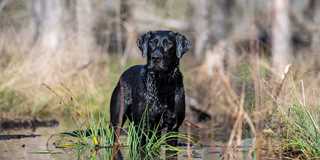
Photo ML ATWATER/UPCLOSEPHOTO.COM
The most popular dog in the United States every year since 2001 and a fixture in duck blinds across North America for decades, the Labrador retriever needs no introduction to waterfowlers. Known for their exceptional sense of smell, Labs are intelligent, good-natured, and eager to please. These qualities make them easy to train and perfect candidates for a number of jobs, including search and rescue, drug detection, services for people with physical challenges, and even military applications. And though Labs can flush (some even point!) upland birds, retrieving ducks and geese is their passion and their reason for being.
"Labs are ideal for waterfowl hunting," says Karl Gunzer, a longtime retriever trainer and now director of the Sporting Dog Group at Nestl Purina PetCare. "I don't think there's a better dog for it. Labs are also one of the easiest dogs for a novice to train."

Photo ML ATWATER/UPCLOSEPHOTO.COM
There are many different kinds of Labs out there of varying shapes, sizes, and colors, and many are bred for different purposes. Gunzer advises hunters to do some research and find the kind of dog they want. "Not all Labs are the same," he says. "A casual hunter or weekend warrior might benefit from a dog that is more laid back, with not as much drive as a field trialer. An outfitter, on the other hand, needs a dog with a lot of drive and stamina. Do your due diligence. Know where a pup's parents came from and what their disposition is like."
Born with a strong desire to retrieve, all Labs benefit from a solid foundation of obedience training, especially when they're young. "An obedient dog will make a good companion and a good hunter," Gunzer explains. "Ninety percent of the issues hunters face in the field come down to basic obedience."
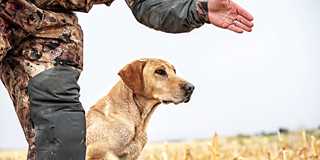
Labs are some of the easiest dogs for a novice to train. Obedience and consistency are keys.
Photo Montana Outdoor Imagery
When training a Lab, Gunzer advises hunters to "set expectations and be consistent." If you let your retriever get away with undesirable behaviors, such as dropping a bird or breaking, it becomes more difficult for the dog to understand what is acceptable and what isn't. "You own what you condone," he says. "If you allow a behavior, that's the behavior you'll get."
According to Gunzer, two of the most useful things to teach your young Lab are place training and crate training. Mastery of these skills will make it easier to teach more advanced skills, like steadiness, later on.
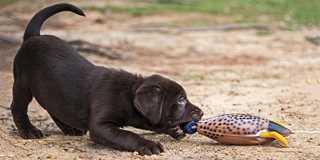
Born with a friendly personality and a strong desire to retrieve, Labs are the most popular breed in the United States.
Photo TODDSTEELEPHOTOART.COM
Finally, Gunzer advises Lab owners to let their dogs live in the house and to spend as much time with them as possible. "There's a reason the Lab has been the number-one dog in the country," he says. "They're versatile, easy to train, have a good temperament, and they make good pets. In competition, most of the dogs that win are dogs that live in the house with their owners. When a dog is used for no other purpose than hunting, the owner is missing some of the great benefits of having a dog."
RETRIEVER FACT
Labrador retrievers are used as guide dogs for the blind more than any other breed.
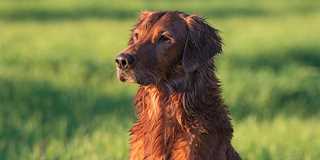
Photo ML ATWATER/UPCLOSEPHOTO.COM
Mark Atwater calls golden retrievers the comedians of the retriever world. "They're an incredible amount of fun," he says. "They're so personable, it's addictive. They want to be part of everything you do." A photographer specializing in working dogs and the owner of Swamp Collie Golden Retrievers in Donalsonville, Georgia, Atwater knows goldens. He and his wife, Shannon, own two of the top-performing goldens in the country.
"We always had Labs until we got our first golden retriever, Yeti," Atwater says. "We heard about a litter from a stunning golden that I had photographed, and I had also photographed the dam. They were very impressive dogs. After Yeti, Shannon wanted one of her own. Now we have five."
Originally bred over a century ago to be hardworking but biddable water dogs, goldens have long been revered for their friendly temperament, excellent nose, desire to please, intelligence, and good looks. Those characteristics led to a relatively recent explosion of dogs bred for the pet market and, in many cases, a dilution of some of the qualities that made them strong hunters.
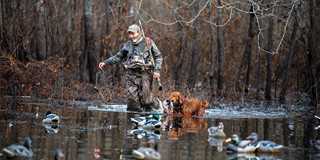
Photo ML ATWATER/UPCLOSEPHOTO.COM
"Today, the golden retriever is a split breed," Atwater explains. "Its origins were as a field dog with an athletic build and a very functional coat, but that is not represented by most of the goldens you see today." Because of this, hunters should be careful when selecting a dog. "Buy a golden out of field-bred dogsones that hunt or come from hunting or competitive field lines." Among other qualities, a field-bred golden will have a coat that's much different from that of dogs bred as pets or show dogs. It's typically much shorter and requires very little maintenancewhat Atwater calls a "wash-and-wear" coat.
"Field goldens are extremely intelligent and have a strong prey drive. If something is moving, they want to catch it," Atwater says. "And their nose blows away any of the other retriever breeds." One of Atwater's favorite golden retriever characteristics is what he calls the "off-switch." He explains, "They'll go a hundred miles an hour when you need them to and then chill out in a nonworking situation."
Though training techniques for golden retrievers are similar to those used for other breeds, these dogs don't respond well to excessive pressure. "You can mess up a golden retriever more quickly by overtraining than by undertraining," Atwater explains. "You have to balance this. It's not how fast you get there; it's how far you go." He advises owners to be patient and to teach first before testing. "Most goldens want to do the right thing. You just have to make it easy for them to do the right thing," he says.
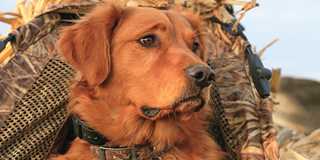
Field-bred goldens are intelligent and athletic and have a strong prey drive. Their signature coat requires minimal maintenance.
Photo Dean Pearson
Goldens might not be for everyone, especially someone who wants a hard-charging hunting machine that lives outside in a kennel when he's not in the field. But for most hunters, owning a golden retriever is just plain fun. "Above all else, goldens are 'people dogs,'" Atwater says. "They have a way of pulling at your heartstrings. And they act like every human was put on Earth just to love them."
RETRIEVER FACT
The first three dogs ever to achieve the American Kennel Club Obedience Champion title were golden retrievers.

Photo ML ATWATER/UPCLOSEPHOTO.COM
Compared to its more pedestrian retriever brethren, the Chesapeake Bay retriever is like an M1 Abrams tank, designed to accomplish the toughest tasks in the worst, most dangerous conditions.
Adam Levy grew up on Long Island hunting big water for sea ducks. He needed a retriever that could deal with cold conditions, big waves, and tough birds. A Chesapeake Bay retriever was the obvious answer. He's now been breeding and training Chessies for more than a decade. Levy and his business partner, Andrew Barbouche, own Next Generation Gun Dog Training in Rochester, Minnesota.
The Chesapeake Bay retriever was named for the region where the breed originated. On the big waters off Maryland's Eastern Shore, hunters wanted a large, strong, and determined dog to retrieve diving ducks. Even with the breed's reputation as tough, gritty, no-nonsense workhorses, Levy says there's much more to appreciate about Chessies. "They're a hard dog on the exterior but a soft dog on the interior," he says.

The Chesapeake Bay Retriever was bred for the toughest conditions. Todays Chessies are good-tempered and hardworking.
Photo Michael Peters
The classic rap against Chesapeake Bay retrievers was that they could be aloof, sometimes aggressive, and standoffish with strangers. Levy says much of that has changed. "Today's Chesapeake Bay retrievers don't have the old-school personality people used to think of," he explains. "Breeders have done a good job breeding good-tempered dogs. Today, we don't have aggressive dogs that don't socialize."
Levy explains that socialization is the key to producing a Chesapeake Bay retriever that performs well in the field and in the home. "As long as they are properly socialized, living and hunting with Chesapeake Bay retrievers is the same as living with any other dog," he says. "Bring your young dog with you everywhere you possibly can, and train with other people and dogs."
Other training approaches that are important for Chessies include patience and minimal repetition. "Because they are good thinkers," Levy says, "they like to evaluate situations on their own. That's why too much repetition is bad." He uses a "pressure on/pressure off" training system. This involves applying pressure, then releasing it when the dog performs the desired behavior. He also says short sessions are always a good idea, as is a force-fetch program.
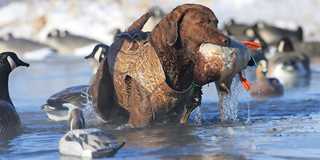
Photo DOUGSTEINEKE.COM
When it comes to selecting a dog, Levy says form follows function, and that a well-formed dog will perform well in the field. Look for a dog with a good coat and strong undercoat, a big-barreled chest, and good rear angulation (the angles of the hip joints).
Though many modern retriever breeds have developed dual lines of hunting dogs and show dogs, a Chessie can excel at both. In fact, Levy's dog Hank is the first Chesapeake to achieve his AKC Master Hunter title and to also win an all-breed best-in-show title.
RETRIEVER FACT
Two Newfoundland dogs, named Sailor and Canton, that were rescued from a shipwreck off the coast of Maryland in 1807 are thought to be the original ancestors of today's Chesapeake Bay retrievers.
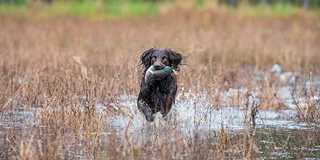
Photo ML ATWATER/UPCLOSEPHOTO.COM
Pam Kadlec, owner of Just Ducky Kennel in Edgefield, South Carolina, started training Labrador retrievers 40 years ago. In 1994, she switched to Boykin spaniels. "I chose Boykins because of their smaller size. I stayed with Boykins because they are very intelligent dogs and, even if you stay one step ahead of them, they will instill humility in their trainers," Kadlec says.
The breed was developed in South Carolina in the early 1900s. Hunters wanted a diminutive retriever that could work well out of the small section boats often used for waterfowling in the region. Interestingly, the Boykin also proved to be a natural turkey hunterthe dog is sent to find and flush a flock of turkeys and then return to his owner, who would call the birds in.
Though they are widely regarded as smart and tough little gundogs, Kadlec points out that "a Boykin is a spaniel, and most spaniels are very sweet-tempered, loving dogs, which makes them ideal as house dogs and family pets that you can also take to the field or marsh." For a long time, it was hard to find a Boykin outside South Carolina. Today, the breed's redeeming qualities as a gundog and a companion have made it popular across the country.
"When choosing a pup for the field, the parents should be hunting dogs," Kadlec says. "With the Boykin becoming more popular, there are a lot of puppies in the market now. It's also important to make sure all the health clearances have been done on the breeding pair, including DNA testing for the breed panel of disorders, and Orthopedic Foundation for Animals clearances for hips, heart, knees, and eyes."
When the time comes to select a puppy from a litter, Kadlec offers the following advice: "Take along a pigeon or quail and see which puppy is interested in retrieving it. Pick up each puppy and see which one makes good eye contact with you. Look for a puppy that wants to be with you, not one who takes off exploring on his own."
You can train a Boykin as you would any other retriever, and it's especially important to set goals for each session before you start. "Boykins will test you to see what they can get away with," Kadlec says. "Some want to do things on their own terms, and they'll play the sympathy card. Treat them fairly and firmly and they will respond with the appropriate behavior. Keep it fun, keep puppy lessons short and positive, set your dog up to succeed, quit on a positive note, and if you're having a bad day, don't train."
RETRIEVER FACT
The Boykin spaniel is the state dog of South Carolina.
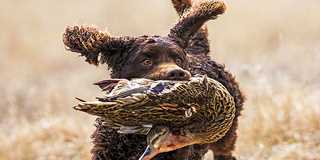
Photo ML ATWATER/UPCLOSEPHOTO.COM
The American water spaniel's name says it all. These dogs are as comfortable in water as they are on land. Though one of the less common retriever breeds, they are known as tenacious gundogs that can handle cold, wet conditions while also being capable flushers in the uplands and good family companions.
"The American water spaniel is the Swiss Army knife of dog breeds," says Tom Waite, owner of Dale Creek Gundogs in Burlington, Wisconsin, and a professional trainer for 27 years. "They can do everything but point, and they find birds that Labs and goldens can't. If I could have only one dog, it would be an American water spaniel."
Developed in Wisconsin and still found mostly in the Upper Midwest today, the American water spaniel is the perfect size (between 32 and 50 pounds) for hunting from small boats or skiffs. Waite advises hunters to look for a dog with a hunting background. "There aren't a lot of American water spaniels being hunt-tested," he says. "Find someone who is using them as working dogs."
Because they are so intelligent, Waite explains, you have to take a different approach to training these dogs than you do with other breeds. "The smarter the dog, the harder to train," he says. "They don't train like a Lab or a golden. But once they're right, they're hard to beat. I'm surprised all the time by how much ability they have, and their retention is huge."
When training, Waite advises hunters to take their time and work through things rather than push through things. "You can't push themthey will break," he says. "You need to teach them." As an example, Waite says it's not uncommon for a Labrador retriever to run 10 to 15 long-distance blind retrieves in a row. With an American water spaniel, four or five retrieves are plenty.
In addition, Waite advises hunters to start dogs young with bird and water exposure, take your time, keep training sessions short and sweet, and end on a positive note. "Patience is huge," he says.
Intelligence, toughness, and versatility are the hallmarks of the breed. "They're a dog that can fall into whatever role you give them," Waite says. "They're great pets, easy to travel with, and very protective. They are also very good at reading people. They have a sixth sense that I don't see in other dogs." Waite notes that the Wisconsin Department of Natural Resources uses American water spaniels to find and retrieve box turtles as part of ongoing research to estimate turtle populations. A Swiss Army knife indeed.
RETRIEVER FACT
According to American Kennel Club estimates, there are probably no more than 3,000 American water spaniels in existence today.
Ducks Unlimited uses cookies to enhance your browsing experience, optimize site functionality, analyze traffic, and deliver personalized advertising through third parties. By continuing to use this site, you agree to our use of cookies. View Privacy Policy